Mocha, a delicious drink that brings together the strong taste of coffee and the sweet richness of chocolate, has won hearts in coffee shops worldwide. Not only is it popular today, but mocha also has a history that’s just as interesting and complex as its flavor. At its heart, a mocha (or caffè mocha) mixes espresso, hot milk, and chocolate. This can mean cocoa powder, chocolate syrup, or melted chocolate. Often topped with whipped cream, mocha strikes a perfect balance between the deep, roasted taste of coffee and the sweet, comforting flavor of chocolate. This blend has made it a hit with both coffee and chocolate fans, adding a special twist and extra delight to the usual coffee drink.
The name “mocha” comes from Mocha, a port city in Yemen that played a big role in the coffee trade from the 15th to the 17th centuries. Known as Al Mokha in Arabic, this city was key to coffee’s history, serving as the main port for exporting Arabica beans. These beans were famous for their high quality and unique tastes, earning the name “Mocha beans.” However, it’s interesting to note that the original Mocha beans didn’t naturally taste like chocolate. The link between chocolate and the mocha drink came about much later, thanks to chefs experimenting and evolving recipes.
The way mocha evolved from a coffee bean to the chocolate and espresso drink we love today shows how adaptable and enduring the drink is. The mocha we know started to come together in the 18th and 19th centuries when chocolate became a favorite ingredient in Europe and America. As coffee and chocolate both became worldwide favorites, it just made sense to combine them into one drink. This led to the creation of mocha coffee, a drink celebrated in cafes and homes everywhere today.
What is a Mocha?
A Caffè Mocha is a chocolate-flavored coffee drink made by combining espresso, steamed milk, and chocolate, originating from the coffee trade in Mocha, Yemen. It is typically enriched with toppings such as whipped cream, marshmallows, or cocoa powder for additional flavor. This beverage offers a sweet and rich taste, making it a favored choice for those seeking a comforting and warming coffee experience.
The Basics of Mocha
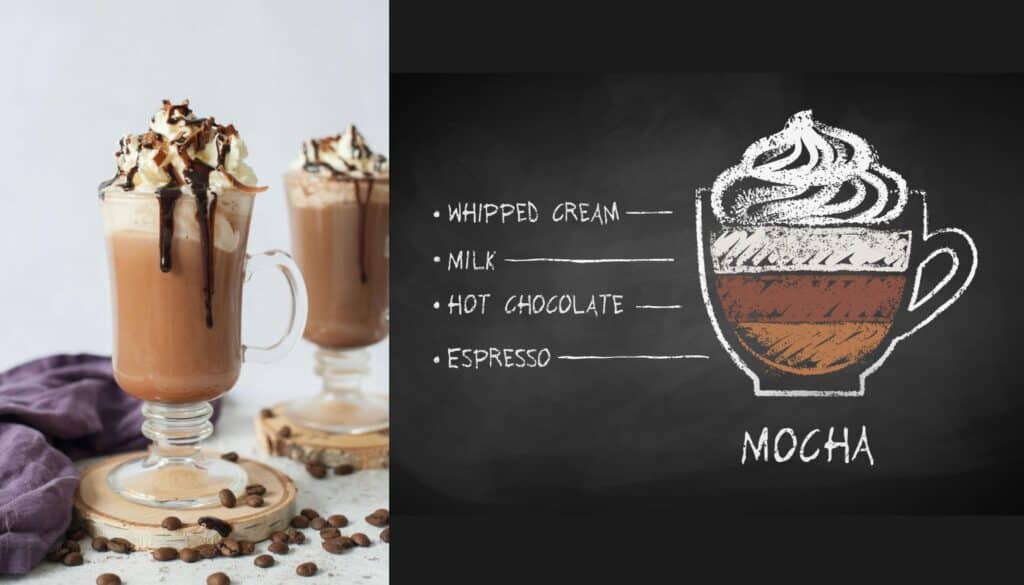
The mocha coffee, often simply referred to as a “mocha,” is a beloved beverage that finds its place between the rich, robust world of espresso and the sweet, indulgent realm of chocolate. Understanding its basics, from what defines a mocha to its key ingredients and how it’s made, reveals the versatility and appeal of this popular coffee drink.
Definition of a Mocha
A mocha is a coffee drink that combines espresso, steamed milk, and chocolate, creating a perfect balance of bitterness from the coffee and sweetness from the chocolate. The name originates from the Mocha beans used historically in coffee trade, but today, it signifies this specific combination of coffee and chocolate flavors. It’s often served with whipped cream on top, adding an extra layer of indulgence.
Key Ingredients and Standard Recipe
Ingredients:
- Espresso: The strong coffee base provides depth and complexity.
- Chocolate: This can be in the form of cocoa powder, chocolate syrup, or even melted chocolate bars, contributing sweetness and chocolatey richness.
- Milk: Steamed milk is mixed with the espresso and chocolate to create a smooth, creamy texture.
- Whipped Cream (optional): Often used as a topping for an added treat.
Standard Recipe:
- Prepare the Espresso: Start by brewing a strong shot of espresso. For a standard-sized cup, one shot (about 1 ounce or 30 milliliters) is sufficient.
- Mix in the Chocolate: Add chocolate to the espresso while it’s still hot. This helps the chocolate meld seamlessly into the coffee. The amount of chocolate can vary according to taste, but a good starting point is about 2 tablespoons of cocoa powder or syrup.
- Steam the Milk: Heat and froth the milk until it’s smooth and creamy, then pour it into the espresso-chocolate mixture. The ratio of milk to coffee can be adjusted based on preference, but a typical mocha uses about 6 to 8 ounces (about 180 to 240 milliliters) of milk.
- Top with Whipped Cream: This is optional but adds a visually appealing and flavorful finish to the drink.
Variations in Preparation Methods
The beauty of mocha lies in its adaptability, allowing for numerous variations that cater to different tastes and dietary preferences. Here are a few popular twists:
- White Mocha: Substitutes regular chocolate with white chocolate, offering a sweeter, creamier flavor.
- Iced Mocha: A chilled version that is perfect for warmer weather, often served with ice and sometimes blended for a smoothie-like texture.
- Vegan Mocha: Utilizes plant-based milk and chocolate options, making the drink accessible to those following a vegan lifestyle.
- Spiced Mocha: Incorporates spices such as cinnamon, nutmeg, or even chili powder to add warmth and complexity to the flavor profile.
Each variation maintains the core identity of a mocha while providing unique experiences, demonstrating the mocha’s versatility and wide appeal. Whether enjoyed in its classic form or through one of its many adaptations, the mocha remains a testament to the harmonious blend of coffee and chocolate.
The History of Mocha
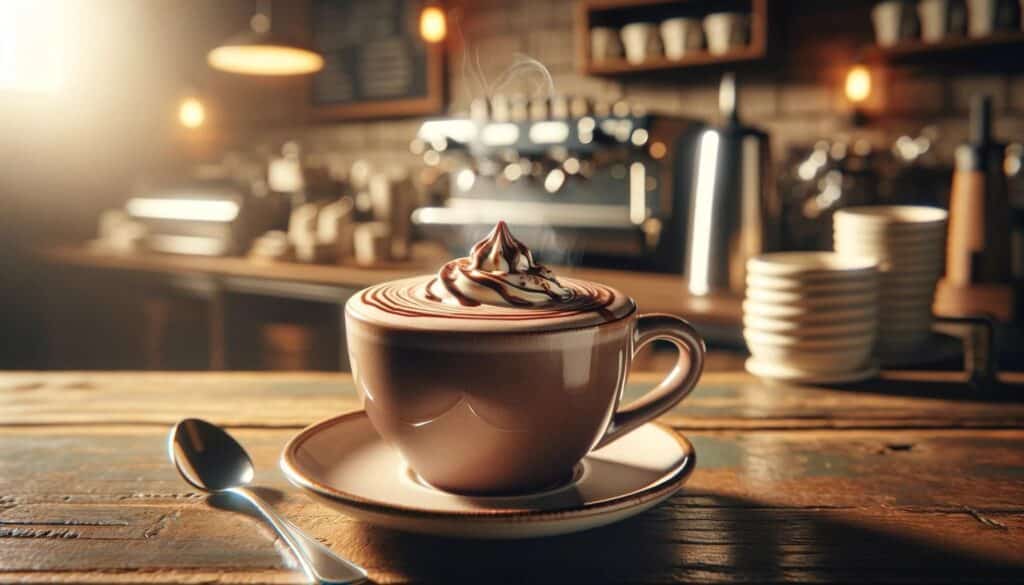
The story of mocha starts with its roots in a bustling trading port and unfolds into the popular coffee drink we all love, covering centuries of history, trade, and kitchen creativity. This journey doesn’t just show mocha’s important spot in the worldwide coffee market but also tells us how this favorite drink of coffee lovers came to be.
The Origin of the Name “Mocha”
“Mocha” got its name from Mocha (or Al Mokha), a port city in Yemen. From the 15th to the 17th centuries, Mocha was a major hub in the coffee business, acting as the go-to port for shipping out Arabica beans. These beans stood out for their special flavor and were among the first coffee beans to travel the globe. “Mocha beans” meant coffee beans from Mocha, celebrated for their distinct taste, often with hints of chocolate. This connection between Mocha’s port and the coffee trade set the stage for linking “mocha” to the coffee-chocolate mix we enjoy now.
Mocha Coffee’s Role in Coffee History
The city of Mocha was key to spreading coffee culture worldwide. As a prime center for coffee trade, Mocha helped Arabica coffee beans go global, sought after for their top-notch quality and taste. This not only boosted coffee drinking in Europe and the Americas but also put Yemen on the map as a major player in coffee history. The global demand for Mocha beans highlighted the region’s impact on coffee culture and tastes worldwide.
How Mocha Coffee Evolved
Originally, Mocha beans didn’t naturally taste like chocolate. The link between mocha drinks and chocolate probably started with European tastes and cooking experiments. Once coffee and chocolate became popular and more available in Europe, especially after cocoa came from the New World, mixing these two ingredients seemed like the next big step in coffee’s evolution.
The mocha coffee we know today started forming in the 18th and 19th centuries. The creation of the espresso machine in the early 20th century also played a part, making stronger coffee bases that went well with chocolate’s rich taste. This era turned “mocha” from a coffee bean type into a loved drink that blends espresso, steamed milk, and chocolate perfectly.
Now, coffee shops worldwide celebrate mocha, offering variations to suit many tastes. Its transformation from a bean to a beverage shows the vibrant history of coffee and how culinary traditions can mix and change over time. The journey of mocha from the busy port of Mocha to coffee menus everywhere shows the lasting charm of mixing coffee and chocolate, keeping it a forever favorite among coffee fans.
Types of Mocha
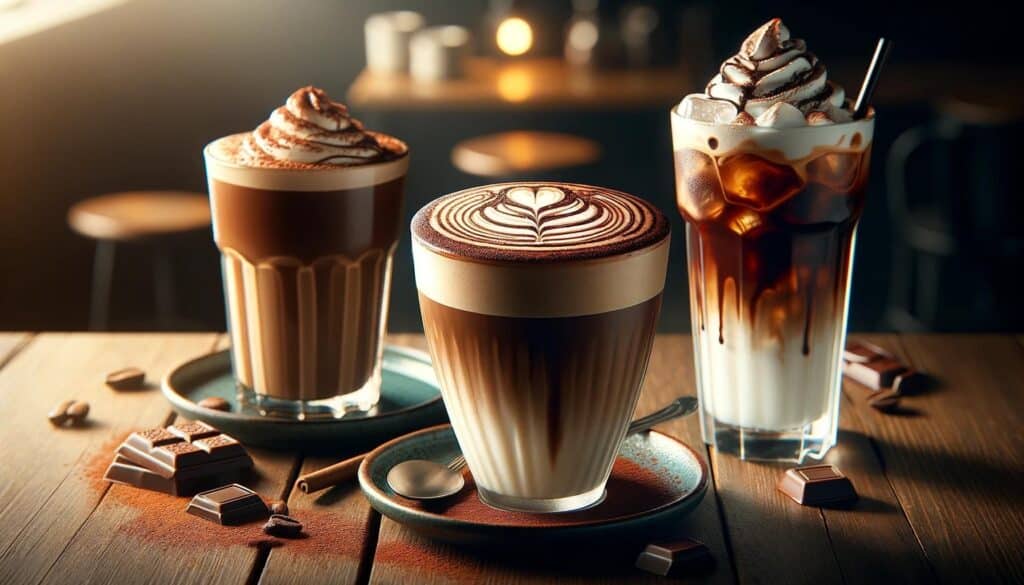
The mocha coffee drink, with its irresistible combination of espresso and chocolate, has inspired a variety of interpretations around the world. From the traditional mocha that many coffee lovers first fall in love with, to creative adaptations like the white mocha and iced mocha, there’s a mocha out there for every palate. Let’s explore the delicious diversity of mocha coffee drinks.
Traditional Mocha Coffee
The traditional mocha coffee is a warm, comforting drink made with a foundation of strong espresso and rich chocolate. The classic recipe involves blending hot espresso with steamed milk and either cocoa powder, chocolate syrup, or melted chocolate, creating a creamy, indulgent beverage that balances the robustness of coffee with the sweetness of chocolate. Often topped with a dollop of whipped cream, this variant is a favorite for those chilly mornings or as a decadent treat.
White Mocha
The white mocha offers a twist on the classic by substituting the dark, rich chocolate with white chocolate. This variant creates a sweeter, creamier drink that pairs wonderfully with the strong espresso base. The white chocolate lends a luxurious texture and a different kind of sweetness compared to the traditional mocha, making it a popular choice for those with a sweet tooth. Like its darker counterpart, the white mocha can be enjoyed with whipped cream on top for an extra layer of indulgence.
Iced Mocha
Perfect for hot summer days, the iced mocha takes the beloved flavors of espresso and chocolate and serves them cold, often over ice. This refreshing version combines chilled espresso or cold brew coffee with chocolate and cold milk, poured over ice to create a cooling, energizing beverage. Some variations include blending the ingredients to create a frappe-like consistency, offering a slushy twist on the traditional mocha. Topped with whipped cream and perhaps a drizzle of chocolate syrup, the iced mocha is a delightful way to enjoy coffee and chocolate in warmer weather.
Mocha Variations Around the World
Across the globe, various cultures have put their unique spin on the mocha, incorporating local flavors and ingredients to create new variations. For example:
- Spiced Mocha: Infused with spices such as cinnamon, cardamom, or nutmeg, offering a warm, aromatic twist on the classic.
- Matcha Mocha: Combining matcha green Caffeine-than-tea/”>tea with the traditional mocha ingredients for a vibrant, antioxidant-rich version.
- Mexican Mocha: Incorporates spices like cinnamon and chili powder, along with dark chocolate, for a drink that’s rich in flavor and warmth.
- Salted Caramel Mocha: A sweet and salty take that adds caramel syrup and a pinch of sea salt to the traditional mocha recipe, creating a complex flavor profile that’s both indulgent and refreshing.
These variations on the mocha illustrate the versatility of the drink and how it can be adapted to suit different tastes and occasions. Whether you prefer the comforting warmth of a traditional mocha, the sweet creaminess of a white mocha, the refreshing chill of an iced version, or the unique flavors of regional adaptations, there’s a mocha variation that’s sure to satisfy your coffee and chocolate cravings.
How to Make the Perfect Mocha at Home
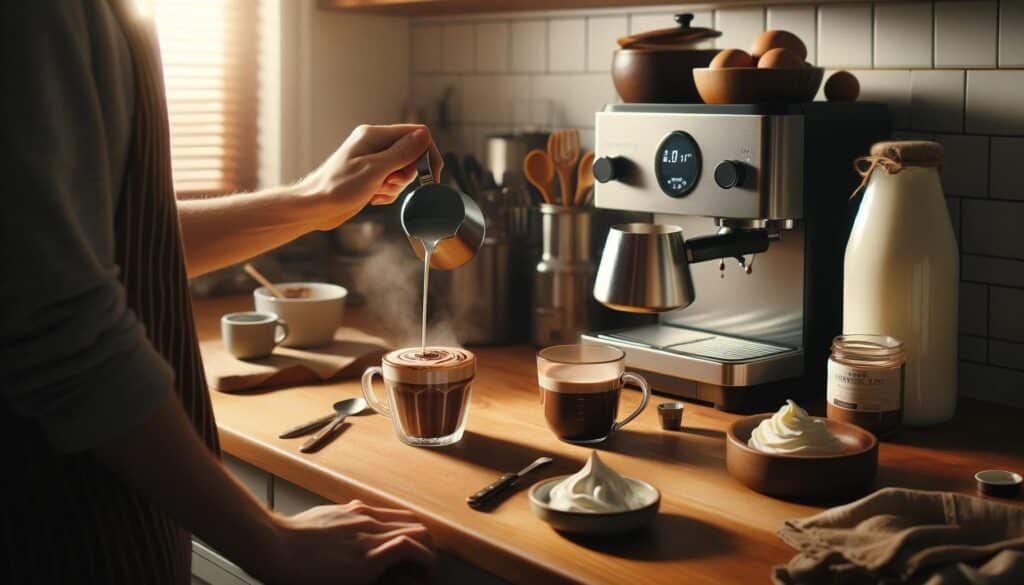
Creating the perfect mocha at home is an art that combines the rich flavors of espresso and chocolate into a single, harmonious cup. With the right ingredients and a bit of practice, you can craft a mocha that rivals your favorite coffee shop’s. Here’s how to get started:
Required Ingredients and Tools
Ingredients:
- Espresso or strong brewed coffee
- Chocolate (cocoa powder, chocolate syrup, or a chocolate bar)
- Milk (dairy or plant-based)
- Sugar (optional, to taste)
- Whipped cream (for topping)
Tools:
- Espresso machine or coffee maker
- Milk frother or small whisk
- Saucepan (if melting chocolate or warming milk)
- Measuring spoons
- Mug
Step-by-Step Guide to Making a Classic Mocha
- Brew the Espresso: Start by brewing a strong shot of espresso. If you don’t have an espresso machine, strong brewed coffee can work as a substitute, though the flavor will be slightly different.
- Prepare the Chocolate: If using cocoa powder or chocolate syrup, add about 2 tablespoons to your mug. For a richer taste, melt a chocolate bar or pieces in a saucepan over low heat or in short bursts in the microwave, stirring until smooth.
- Mix Chocolate and Espresso: Pour the hot espresso over the chocolate in the mug. Stir until the chocolate is completely melted and the mixture is smooth. If you’re using sugar, add it now according to your taste preference and stir until dissolved.
- Froth the Milk: Heat the milk until warm but not boiling. Use a milk frother to create a creamy froth, or whisk vigorously by hand. For an extra touch of luxury, steam the milk if you have an espresso machine with a steam wand.
- Combine and Serve: Pour the frothed milk into your mug, stirring gently to combine with the chocolate-espresso mixture. Leave some foam on top and, if desired, add a dollop of whipped cream.
- Garnish: For a finishing touch, sprinkle with a little cocoa powder, chocolate shavings, or even a drizzle of chocolate syrup.
Tips for Customizing Your Mocha
- Adjusting Sweetness: Start with less sugar or chocolate and taste as you go. You can always add more if needed.
- Strength of Coffee: If you prefer a stronger coffee flavor, add an extra shot of espresso or increase the coffee-to-milk ratio.
- Type of Chocolate: Experiment with different types of chocolate (dark, milk, white) to find your favorite flavor profile.
- Milk Alternatives: For a dairy-free version, almond, coconut, or oat milk are excellent alternatives that can add unique flavors.
- Spices and Flavors: Consider adding a pinch of cinnamon, nutmeg, or vanilla extract to the chocolate mixture for an aromatic twist.
- Cold Variations: For an iced mocha, simply use cold milk and serve over ice. Blend with ice for a frappé-style drink.
With these guidelines, you can enjoy a luxurious mocha in the comfort of your home, tailored exactly to your preferences. Happy brewing!
The Role of Chocolate in Mocha
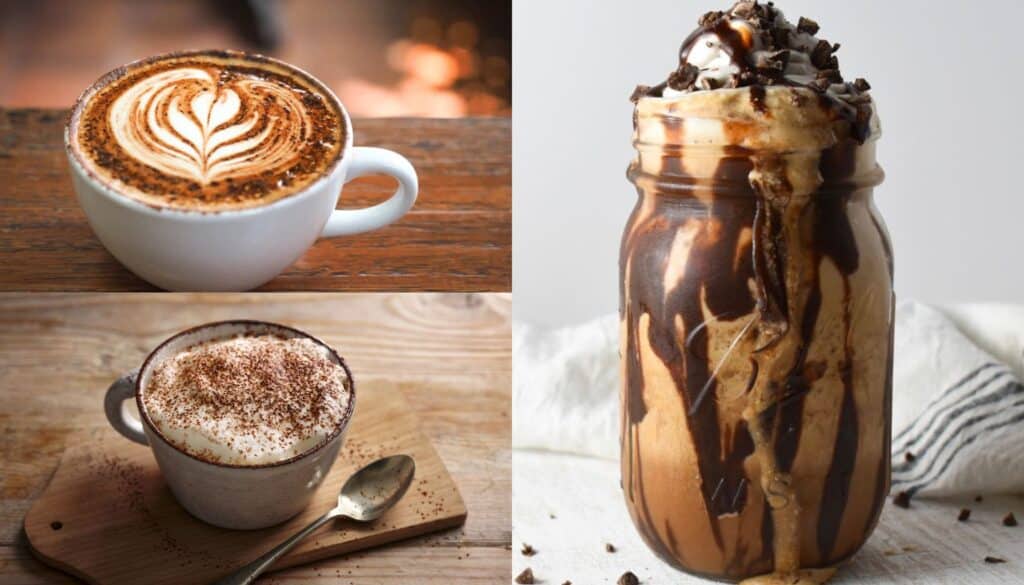
Chocolate is not just an ingredient in mocha; it’s the soul that complements the espresso’s robust character, creating a beverage that’s much more than the sum of its parts. The type of chocolate used and its quality can significantly influence the flavor profile, texture, and overall enjoyment of the mocha. Understanding how chocolate integrates with coffee and the impact of different chocolate forms can elevate your mocha experience.
Types of Chocolate Used in Mocha
- Cocoa Powder: Provides a rich, deep chocolate flavor and is often used for a more traditional mocha. Unsweetened cocoa powder offers control over the sweetness level, allowing the natural bitterness of both the cocoa and the espresso to shine through and balance with any added sweeteners.
- Chocolate Syrup: A convenient option that blends easily into the drink, offering a smooth, consistent chocolate flavor. Syrups can vary in sweetness and chocolate intensity, making it easy to adjust to personal taste preferences.
- Chocolate Bars (Solid Chocolate): Melting high-quality chocolate bars into the mocha can introduce a luxurious texture and complex chocolate flavors. The cocoa content and origin of the chocolate bar can greatly influence the mocha’s final taste, offering endless possibilities for customization.
The Impact of Chocolate Quality on the Mocha’s Flavor
The quality of chocolate plays a critical role in defining the mocha’s overall flavor. High-quality chocolate, characterized by a higher cocoa content and minimal additives, can provide a depth of flavor and richness that elevates the mocha beyond a simple coffee drink. It can introduce nuanced flavors, such as fruity, nutty, or floral notes, that enhance the complexity of the espresso. Conversely, lower-quality chocolate or overly sweetened syrups might mask the espresso’s intricate flavors, leading to a less balanced and more monolithic taste profile.
Exploring the Balance Between Coffee and Chocolate Flavors
Achieving the perfect balance between coffee and chocolate in a mocha is an artful pursuit that depends on personal taste and the characteristics of the ingredients used. Here are some considerations:
- Coffee Strength: The intensity of the espresso should complement the richness of the chocolate without overpowering it. A strong, bold espresso works well with dark chocolate, while a lighter roast might pair better with milk chocolate or white chocolate.
- Chocolate Sweetness: The sweetness of the chocolate should harmonize with the natural bitterness of the coffee, creating a beverage that is neither too bitter nor overly sweet. Adjusting the amount of chocolate or adding sweeteners can help fine-tune this balance.
- Flavor Enhancements: Adding a dash of cinnamon, vanilla extract, or a pinch of salt can help bridge the flavors of coffee and chocolate, bringing out the best in both.
Experimenting with different types of chocolate, adjusting ratios, and even incorporating specialty coffees can lead to the discovery of your perfect mocha. The goal is to create a harmonious blend where the chocolate enhances the coffee without overshadowing it, resulting in a rich, comforting, and satisfying drink.
Health Aspects of Mocha
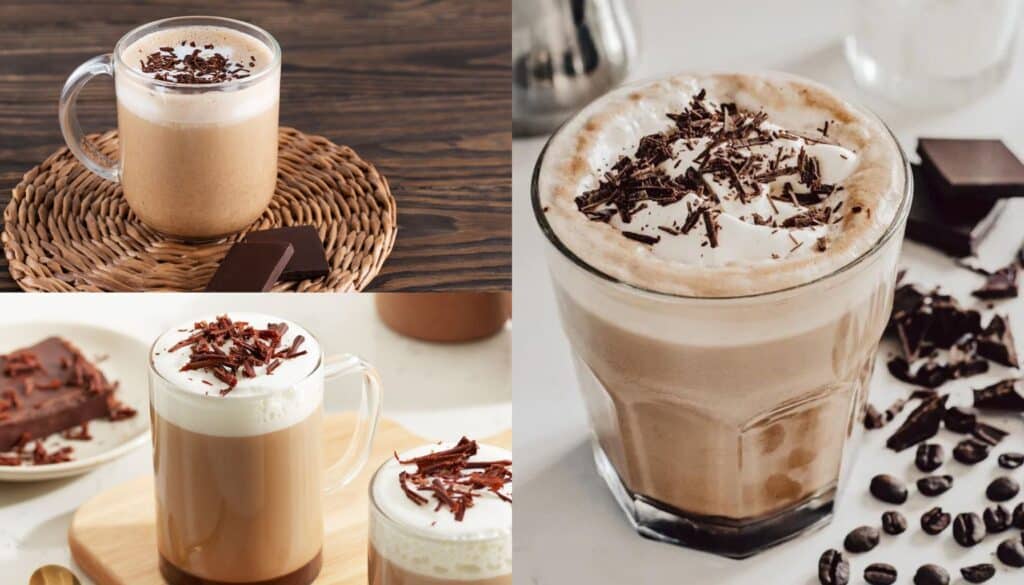
Mocha coffee, with its delightful blend of espresso, milk, and chocolate, sits at the intersection of a coffee drink and a sweet treat. While it’s a favorite choice for many looking to indulge, understanding its health aspects can help you enjoy it as part of a balanced diet. Here’s a breakdown of the nutritional overview, the benefits and drawbacks of consuming mocha, and how it compares to other coffee drinks in terms of healthiness.
Nutritional Overview of a Standard Mocha
A standard mocha made with whole milk and chocolate syrup contains approximately:
- Calories: 250-400 (depending on the size and chocolate content)
- Fat: 8-15 grams
- Saturated Fat: 5-9 grams
- Carbohydrates: 35-50 grams
- Sugars: 25-40 grams
- Protein: 8-12 grams
- Caffeine: 95-175 mg
The exact nutritional content can vary based on the specific ingredients used (such as the type of milk or chocolate) and the portion sizes.
Benefits and Drawbacks of Consuming Mocha
Benefits:
- Mood Enhancement: The chocolate in mocha can stimulate the production of endorphins, contributing to mood improvement and a sense of pleasure.
- Antioxidants: Both coffee and cocoa are rich in antioxidants, which can help reduce oxidative stress and lower the risk of some diseases.
- Energy Boost: The caffeine from espresso provides a quick energy boost, enhancing alertness and concentration.
Drawbacks:
- High Caloric Content: Mochas can be high in calories and sugar, particularly when made with whole milk and sweetened chocolate, contributing to weight gain if consumed frequently.
- Sugar Content: High sugar intake is associated with an increased risk of type 2 diabetes, heart disease, and other health issues.
- Caffeine Sensitivity: For those sensitive to caffeine, consuming mocha can lead to restlessness, anxiety, and sleep disturbances.
Comparing the Healthiness of Mocha to Other Coffee Drinks
- Black Coffee: Contains almost no calories and no sugar, making it a healthier option for those monitoring calorie or sugar intake.
- Latte: Similar to mocha in calorie and fat content when made with whole milk, but without the added sugars and calories from chocolate.
- Cappuccino: Generally, has fewer calories than mocha because it contains less milk and no chocolate, making it a lighter option.
- Frappuccino® and other blended drinks: These can contain even more sugar and calories than a standard mocha, especially with added syrups, whipped cream, and toppings.
Making Mocha Healthier
To enjoy mocha in a healthier way, consider modifications like using low-fat or plant-based milk, reducing the amount of chocolate syrup or using dark chocolate with a higher cocoa content (which has less sugar), and skipping or reducing whipped cream toppings. These adjustments can help lower the caloric and sugar content while still allowing you to enjoy the rich flavors of mocha.
In conclusion, while mocha can be a delicious indulgence, being mindful of its ingredients and nutritional content can help you make informed choices that fit within a healthy, balanced lifestyle.
Mocha in Coffee Culture
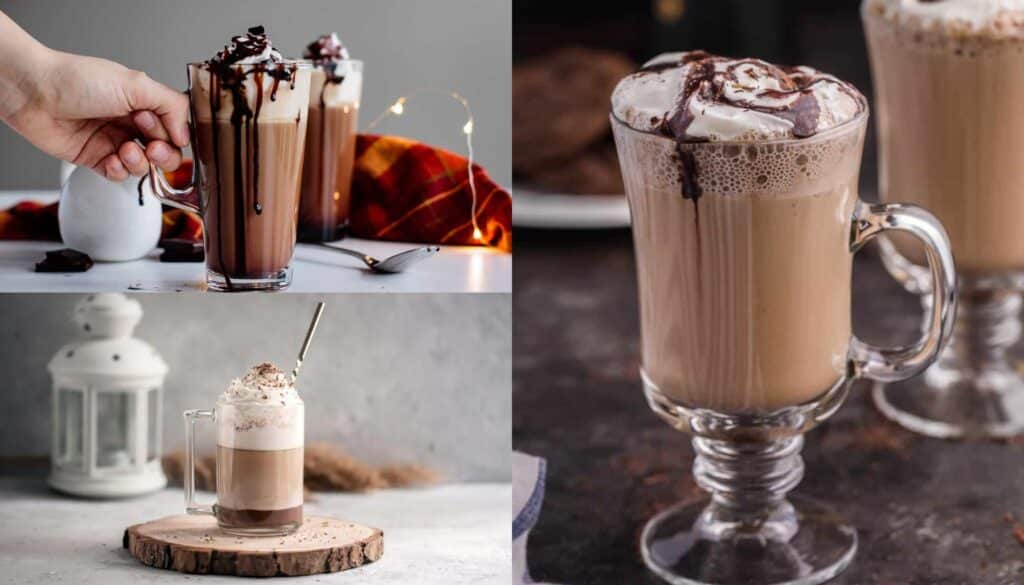
Mocha stands out in the coffee world by mixing the strong taste of espresso with the sweet goodness of chocolate, making a drink that a lot of people love. It finds a special spot in today’s coffee scene, connecting the classic espresso drinks with the sweeter, dessert-like options that are now popular in coffee shops everywhere.
Mocha’s Role in Today’s Coffee Scene
Today, everyone celebrates mocha for being so flexible and appealing to different tastes. For those who think regular espresso drinks are too sharp, mocha offers a sweeter, richer choice that still keeps the coffee vibe. It also catches the attention of people who like to try new things, letting them add various flavors and twists—from spicy and rich to sweet and luxurious. Its continued success shows that more and more, coffee lovers want drinks they can tailor to their own tastes and dietary needs.
Why Mocha Is a Must-Have in Coffee Shops Globally
You’ll find mocha on the menu of nearly every coffee shop, from big-name chains to small local spots. Its easy-to-find status proves it’s not just a seasonal special; people crave it all year. Coffee shops often have different takes on mocha, like white chocolate mocha, spiced mocha, and iced mocha, aiming to please the ever-changing preferences of their customers. Mocha’s ability to fit in with different cultures shines through in local versions that include regional flavors and ingredients, offering unique twists that reflect local tastes and traditions.
Mocha’s Impact on Coffee Trends and What People Like
Mocha has really helped shape today’s coffee trends, especially those that focus on trying out new flavors and enjoying the experience. Its popularity has made other flavored and specialty coffee drinks more common, inspiring coffee shops and baristas to get creative with their mixes and ingredients. People’s love for mocha and its variations also shows that many are looking for drinks that comfort them and treat their senses, turning coffee from just a morning boost into a chance to enjoy and discover new tastes.
Mocha’s ability to adapt to different diets and preferences, like vegan or sugar-free options, matches up with wider trends towards making food and drinks more inclusive and customizable. As people become more aware of their health and the environment, mocha’s flexibility with alternative milks and sweeteners keeps it relevant and popular.
In the end, mocha’s rich taste and ability to change have made it a favorite among coffee fans worldwide. It shows its impact on coffee culture by linking traditional and modern flavors, sparking innovation while still celebrating the classic mix of coffee and chocolate. As coffee culture keeps evolving, mocha stands as a symbol of coffee’s lasting comfort and its potential for culinary creativity.
DIY Mocha: Beyond the Basics
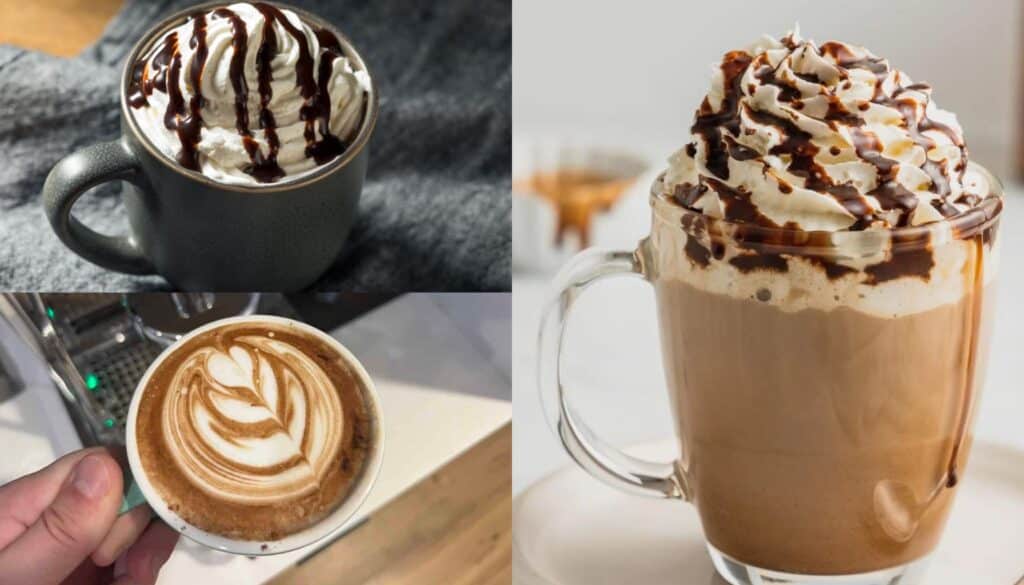
Elevating your mocha game at home means venturing beyond the classic recipe to explore innovative twists, alternative ingredients, and seasonal variations that can transform your coffee experience. Whether you’re a fan of the traditional mocha or looking for something a little different, there are endless possibilities to experiment with. Here are some ideas to inspire your next mocha creation.
Innovative Recipes and Twists on the Classic Mocha
- Salted Caramel Mocha: Add a drizzle of salted caramel sauce to your classic mocha for a sweet and salty kick. Top with whipped cream and a sprinkle of sea salt for an extra decadent treat.
- Mocha Coconut Latte: Substitute regular milk with coconut milk and add a touch of coconut syrup to your mocha. The result is a tropical twist on the traditional mocha, perfect for those who love a hint of coconut flavor.
- Chai Spice Mocha: Mix in a pinch of chai spice blend (cinnamon, cardamom, ginger, cloves, and nutmeg) with your cocoa powder before combining it with the espresso. This adds a warm, aromatic layer to the rich mocha flavor.
- Peppermint Mocha: Ideal for the holiday season, add a few drops of peppermint extract or peppermint syrup to your mocha. Garnish with whipped cream and crushed peppermint candies for a festive touch.
Incorporating Alternative Milks and Sweeteners
- Almond Milk Mocha: For a lighter, nutty flavor, use almond milk in place of dairy milk. Almond milk pairs well with both chocolate and coffee, creating a mocha that’s both flavorful and dairy-free.
- Oat Milk Honey Cinnamon Mocha: Oat milk’s creamy texture makes it a great choice for mochas. Sweeten your mocha with honey instead of sugar, and add a dash of cinnamon for a comforting, subtly spiced drink.
- Stevia-Sweetened Dark Chocolate Mocha: For a lower-calorie option, use stevia or another low-calorie sweetener in place of sugar, and opt for dark chocolate with a high cocoa content to reduce sugar content without sacrificing the chocolatey goodness.
Seasonal and Festive Mocha Recipes
- Pumpkin Spice Mocha: Incorporate a spoonful of pumpkin puree and a dash of pumpkin spice into your mocha for an autumn-inspired twist. Top with whipped cream and a sprinkle of pumpkin spice for the full fall effect.
- Gingerbread Mocha: Add gingerbread syrup (or a homemade mix of ginger, cinnamon, and molasses) to your mocha for a holiday treat. Decorate with whipped cream and a tiny gingerbread cookie on the side.
- Iced Berry Mocha for Summer: Blend your mocha with ice for a refreshing summer drink and mix in some fresh or frozen berries for a fruity twist. Serve cold with a berry skewer garnish.
Each of these variations offers a new way to enjoy the classic mocha, whether you’re looking for something to suit a dietary preference, in search of a seasonal treat, or just wanting to shake up your coffee routine. Experimenting with these ideas can lead to discovering your new favorite way to enjoy mocha at home.
Conclusion
Mocha, with its rich blend of espresso and chocolate, stands as a testament to the creative and indulgent spirit of coffee culture. This beloved drink strikes a harmonious balance between the boldness of coffee and the sweetness of chocolate, offering a sensory experience that is both comforting and luxurious. The versatility of mocha, allowing for countless variations and adaptations, underscores its unique position in the coffee world.
From the classic mocha that warms a chilly morning to innovative versions that incorporate spices, seasonal flavors, and alternative ingredients, there is a mocha for every taste and occasion. The ability to customize mocha—adjusting its sweetness, experimenting with different types of chocolate, and substituting milk options—makes it a canvas for creativity and personal preference.
Moreover, the mocha’s rich history, from the coffee trade routes of Yemen to the modern-day café, adds depth to its enjoyment, connecting coffee lovers to a tradition that spans centuries and continents. Whether enjoyed in its simplest form or as a base for more elaborate creations, the mocha remains a beloved choice for its ability to satisfy both the need for caffeine and the craving for something sweet.
As we’ve explored the intricacies of mocha, from its origins to the ways it can be adapted and enjoyed today, it’s clear that this drink is much more than just a coffee staple—it’s a celebration of flavor, history, and personal expression. Whether you’re brewing at home or sampling the offerings of your local café, there’s always an opportunity to discover a new dimension of mocha. So, I encourage you to experiment with the recipes and variations we’ve discussed, or even invent your own, and continue to enjoy the rich, comforting, and endlessly versatile world of mocha coffee.
Frequently Asked Questions About Mocha
1. Can I make a mocha without an espresso machine?
Absolutely! While traditional mocha is made with espresso, you can substitute strong brewed coffee for a similar effect. Just brew your coffee a bit stronger than usual to mimic the bold flavor of espresso. The key is to maintain the rich coffee flavor that balances well with the chocolate.
2. What’s the difference between a mocha and a hot chocolate with coffee added?
The primary difference lies in the coffee-to-chocolate ratio and the preparation method. A mocha typically starts with a base of espresso, to which chocolate and milk are added, creating a beverage where coffee is the dominant flavor, complemented by chocolate. In contrast, adding coffee to hot chocolate simply introduces a coffee flavor to a primarily chocolate drink, making the chocolate the dominant note.
3. Is it possible to make a mocha using white chocolate?
Yes, and it’s called a White Mocha! White mocha swaps the traditional dark or milk chocolate for white chocolate, resulting in a sweeter, creamier drink. The process is the same, but white chocolate provides a different flavor profile, offering a delicious alternative for those who prefer their mocha on the sweeter side.
4. How can I make a vegan mocha?
Making a vegan mocha is easy and delicious. Use plant-based milk (such as almond, soy, oat, or coconut milk) in place of dairy milk, and ensure your chocolate source is vegan (many dark chocolates are naturally vegan, but always check the label). Use a vegan whipped cream alternative for topping, and you’ll have a delightful vegan mocha.
5. Can mocha be made sugar-free or low-calorie?
Yes, a mocha can be adapted to be sugar-free or lower in calories. Use unsweetened cocoa powder or a sugar-free chocolate syrup for the chocolate component, and opt for a sugar substitute if additional sweetness is desired. Choosing low-fat or plant-based milk can also reduce calories. These adjustments allow you to enjoy the rich flavors of mocha without the added sugar and calories.

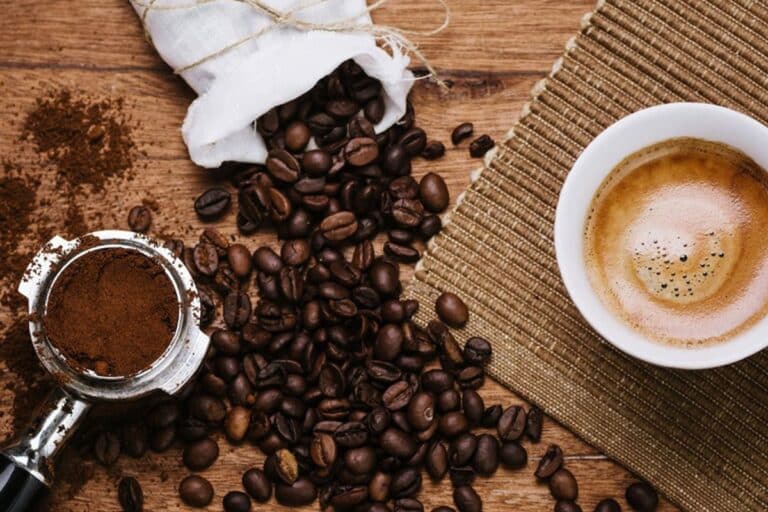
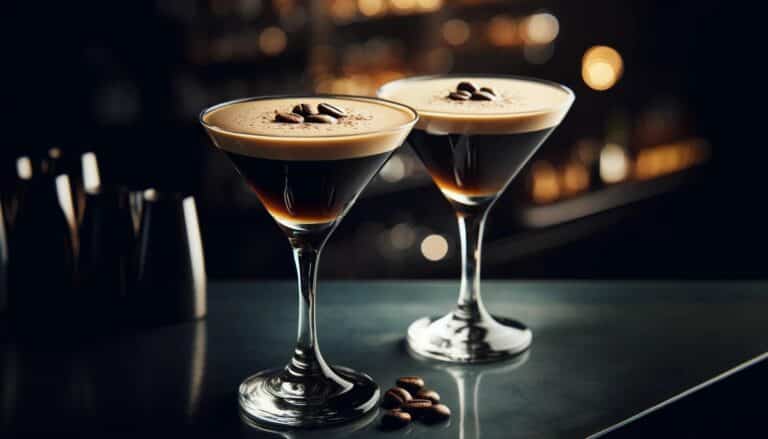


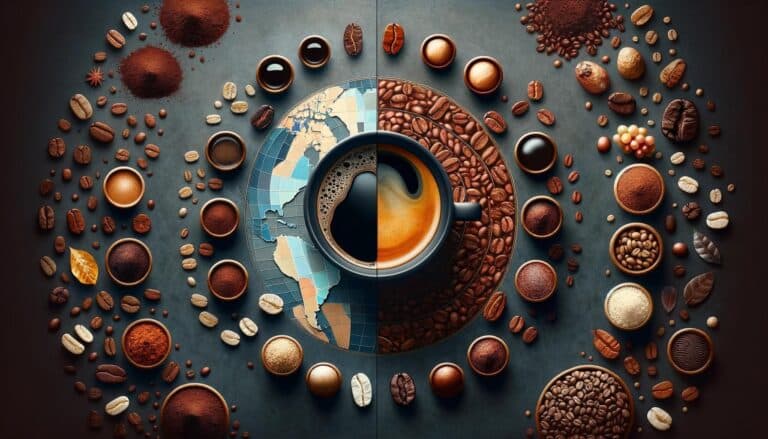

1 thought on “What is a Mocha?”
Pingback: How to Make a Mocha Coffee - Alpine Mountain Coffee